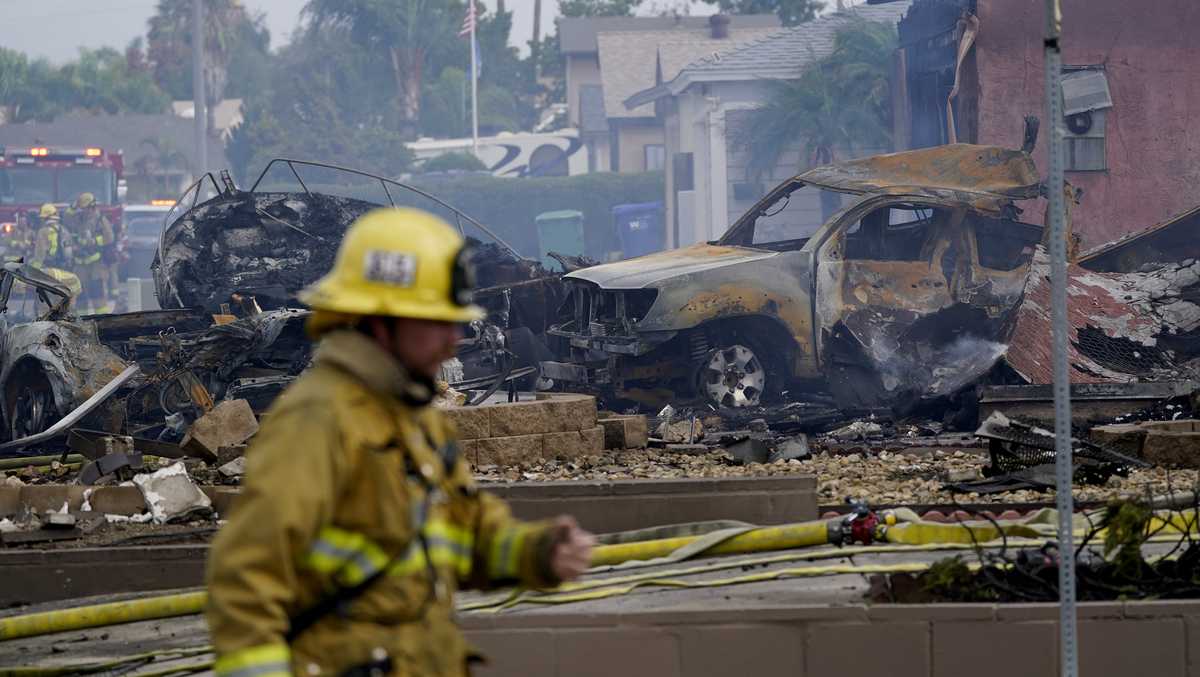Tragedy in the Fog as Private Jet Crashes into San Diego Neighborhood Leaving Six Presumed Dead
A Quiet Morning Shattered by Disaster
In the early hours of Thursday morning, the calm of a fog-shrouded San Diego neighborhood was abruptly shattered when a private jet crashed into a residential area in Murphy Canyon. The aircraft, a Cessna 550 business jet, was on final approach to Montgomery-Gibbs Executive Airport when it slammed into homes and vehicles, engulfing the area in fire and chaos.
Authorities have confirmed that all six people aboard the jet are presumed dead. Among them was Dave Shapiro, co-founder of a prominent San Diego-based music talent agency, and two of his colleagues. Their loss has rippled across the entertainment industry and devastated the local community.
Widespread Destruction Amid the Debris
The crash site resembled a war zone. Houses were partially consumed by flames, vehicles flattened or melted, and debris was scattered across a wide radius. The fire ignited by the crash scorched several homes and obliterated cars, creating an eerie contrast of destruction—some homes incinerated, others across the street untouched.
Assistant Chief Dan Eddy of the San Diego Fire-Rescue Department described the aftermath as a "gigantic debris field," noting that parts of the aircraft were scattered over a wide area. The pungent smell of jet fuel and burning wood lingered for hours, even blocks from the crash site.
Despite the magnitude of the crash, no local residents were killed. However, at least eight people sustained minor injuries, and nearly 100 were evacuated. One individual was hospitalized, while others were cared for at a nearby evacuation center.
A Close-Knit Community in Shock
Residents of Murphy Canyon, a military housing community, were jolted awake by what many described as an explosion resembling an earthquake. Some families were forced to flee their homes in the dead of night, leaping from windows and dodging flames.
City Councilmember Raul Campillo commended the bravery of residents and first responders. “Military families were helping each other—pulling each other from danger, avoiding fire,” he said. “There were many miracles and heroic actions.”
Many residents expressed confusion and fear about the extent of the damage. "How did it go from there to there?" one young boy wondered aloud, puzzled by the randomness of destruction that left one car melted down to its frame, while nearby homes were untouched.
Flight Path and Timeline
The ill-fated jet departed Teterboro Airport in New Jersey at 11:15 p.m. ET on Wednesday, stopping briefly in Wichita, Kansas. It was scheduled to land at Montgomery-Gibbs Executive Airport, just three miles from where it ultimately crashed.
At approximately 3:40 a.m. PT, the pilot radioed that they were three miles from landing. There was no distress call or indication of malfunction. Just seven minutes later, at 3:47 a.m., the aircraft collided with power lines and crashed into a home.
Weather and Visibility Challenges
The crash occurred during dense fog conditions, with visibility around the nearby Marine Corps Air Station Miramar dropping to just a quarter mile shortly after 4 a.m. A marine layer had pushed inland, creating a dangerous and rapidly changing weather scenario.
Eliott Simpson, a lead investigator from the National Transportation Safety Board (NTSB), confirmed the aircraft first clipped power lines before ultimately crashing. He emphasized the aircraft was operating in “very poor weather conditions.”
What Investigators Are Focusing On
The NTSB, along with the FAA, is investigating multiple factors that may have contributed to the crash. Experts believe weather, pilot fatigue, and navigational challenges could all have played a role.
“This kind of accident is never caused by a single factor,” said Thomas Anthony, director of the Aviation Safety and Security Program at USC. “It’s always a confluence of hazards—environmental, mechanical, and human.”
One key area of interest is how long the pilots had been awake, considering the long cross-country flight and early-morning landing. Fatigue, experts warn, can critically impair decision-making and communication in high-pressure situations.
Despite the airport control tower being unstaffed at the time—common during overnight hours—Anthony believes the weather and timing are likely the most crucial elements under scrutiny.
Tragedy in the Skies, Mourning on the Ground
For the families and colleagues of those lost aboard the jet, the tragedy is immeasurable. A statement from the music talent agency expressed heartbreak over the deaths of their team members, requesting privacy as they grieve.
The investigation will take time, and officials have not provided a timeline for when displaced families can return home. Meanwhile, the neighborhood remains cordoned off as crews sift through wreckage and work to restore power and safety to the area.
For the Murphy Canyon community, this crash is not just a tragic accident—it’s a haunting reminder of how swiftly life can change, and how vital the bonds of community become in the face of devastation.
